A Study on the Bearing Capacity of Square Skirted Anchors with Different Mooring Points
Abstract
:1. Introduction
2. Model Tests
2.1. Model Test Setup
2.2. Skirted Anchor Model
2.3. Soil Parameters
2.4. Test Procedures
- The skirted anchor was slowly and uniformly pressed into the clay, as shown in Figure 1b, using a loading motor and a loading rod until the top plate of the skirted anchor model was aligned with the surface of the clay layer.
- The pull rings on the top point ST and middle point SC of the side skirt of the square skirted anchor were selected and connected to the steel wire rope.
- The loading control system was turned on with a loading rate set as 2 mm/min, and the steel wire rope was tightened.
- The data acquisition device was turned on, and all sensors were reset to zero.
- The loading motor was started to apply horizontal or inclined loads to the square skirted anchor. The test was stopped when the measured force significantly decreased or no longer changed. The displacement and force applied to the square skirted anchor were recorded during the test.
2.5. Test Results
3. Numerical Modeling
3.1. Model Description
3.2. Verification
3.3. Calculation Scheme
3.4. Failure Mechanism and Bearing Capacity
3.5. Failure Envelopes
4. Conclusions
Author Contributions
Funding
Institutional Review Board Statement
Informed Consent Statement
Data Availability Statement
Conflicts of Interest
References
- Ding, H.; Zhu, Y.; Zhang, P.; Le, C. Optimal skirt spacing for subsea skirted foundation considering floating stability. Trans. Tianjin Univ. 2017, 23, 445–450. [Google Scholar] [CrossRef]
- Feng, X.; Gourvenec, S.; Randolph, F.M. Optimal skirt spacing for subsea mudmats under loading in six degrees of freedom. Appl. Ocean Res. 2014, 48, 10–20. [Google Scholar] [CrossRef]
- Choo, Y.W.; Kang, T.W.; Seo, J.H.; Youn, J.U.; Hossain, M.S. Centrifuge study on undrained and drained behaviors of a laterally loaded bucket foundation in a silty sand. In Proceedings of the International Ocean and Polar Engineering Conference, Big Island, HI, USA, 21–26 June 2015. [Google Scholar]
- Fu, D.; Gaudin, C.; Bienen, B.; Tian, Y.; Cassidy, J.M. Combined load capacity of a preloaded skirted circular foundation in clay. J. Geotech. Geoenviron. Eng. 2018, 144, 04018084. [Google Scholar] [CrossRef]
- Gourvenec, S.; Randolph, F.M. Consolidation beneath circular skirted foundations. Int. J. Geomech. 2010, 10, 22–29. [Google Scholar] [CrossRef]
- Hu, Y.; Randolph, F.M.; Watson, P.G. Bearing response of skirted foundation on nonhomogeneous soil. J. Geotech. Geoenviron. Eng. 1999, 125, 924–935. [Google Scholar] [CrossRef]
- Mehravar, M.; Harireche, O.; Faramarzi, A. Evaluation of undrained failure envelopes of caisson foundations under combined loading. Appl. Ocean Res. 2016, 59, 129–137. [Google Scholar] [CrossRef]
- Sun, L.; Zhang, Y.; Feng, X.; Gourvenec, S.; Li, S. Upper-bound solutions for inclined capacity of suction caissons in a trenched seabed. Géotechnique 2023, 74, 473–485. [Google Scholar] [CrossRef]
- Zhang, Y.; Wang, Y.; Li, D.; Mao, D. Bearing capacity and soil deformation around modified suction caisson in clay under monotonic horizontal loading. Mar. Georesour. Geotechnol. 2023, 41, 959–968. [Google Scholar] [CrossRef]
- Zhu, B.; Zhang, W.; Ying, P.; Chen, Y. Deflection-Based Bearing Capacity of Suction Caisson Foundations of Offshore Wind Turbines. Geotech. Geoenviron. Eng. 2014, 140, 04014013. [Google Scholar] [CrossRef]
- Bienen, B.; Gaudin, C.; Cassidy, M.J. Numerical modelling of a hybrid skirted foundation under combined loading. Comput. Geotech. 2012, 45, 127–139. [Google Scholar] [CrossRef]
- Cai, W.; Zhan, J.; Gong, Y. Further investigation of the six-DOF hollow gravity anchor: Impact of the internal slant angle. Mar. Struct. 2017, 56, 85–98. [Google Scholar] [CrossRef]
- Houlsby, G.; Kelly, R.; Huxtable, J.; Byrne, B. Field trials of suction caissons in clay for offshore wind turbine foundations. Géotechnique 2005, 55, 287–296. [Google Scholar] [CrossRef]
- Li, D.; Feng, L.; Zhang, Y. Model tests of modified suction caissons in marine sand under monotonic lateral combined loading. Appl. Ocean Res. 2014, 48, 137–147. [Google Scholar] [CrossRef]
- Li, D.; Zhang, Y.; Feng, L. Capacity of modified suction caissons in marine sand under static horizontal loading. Ocean Eng. 2015, 102, 1–16. [Google Scholar] [CrossRef]
- Watson, P.G.; Randolph, F.M. Failure envelopes for caisson foundations in calcareous sediments. Appl. Ocean Res. 2018, 20, 83–94. [Google Scholar] [CrossRef]
- Martin, C.M. Physical and Numerical Modelling of Offshore Foundations under Combined Loads. Ph.D. Thesis, Oxford University, Oxford, UK, 1994. [Google Scholar]
- Martin, C.M.; Houlsby, G.T. Combined loading of spudcan foundations on clay: Numerical modelling. Géotechnique 2001, 51, 687–699. [Google Scholar] [CrossRef]
- Sloan, S.W. Lower bound limit analysis using finite elements and linear programming. Int. J. Numer. Anal. Methods Geomech. 1988, 12, 61–77. [Google Scholar] [CrossRef]
- Sun, M.; Zhao, S.; Li, W.; Sun, Z.; Peng, M.; Xu, H. Probabilistic analysis on the lateral capacity of suction caissons in spatially variable soils. Mar. Georesour. Geotechnol. 2023, 42, 1011–1022. [Google Scholar] [CrossRef]
- Tang, X.; Zhang, X.; Shao, Q.; Li, Z. Rotation Center and Horizontal Bearing Capacity of the Bucket Foundation in Soft Ground. Mar. Georesour. Geotechnol. 2015, 34, 594–601. [Google Scholar] [CrossRef]
- Sloan, S.W.; Kleeman, P.W. Upper bound limit analysis using discontinuous velocity fields. Comput. Methods Appl. Mech. Eng. 1995, 127, 293–314. [Google Scholar] [CrossRef]
- Yu, J.; Wang, H.; Huang, M.; Leung, C.F. Upper-bound analysis of laterally loaded rigid monopiles in clay with linearly increasing strength. Can. Geotech. J. 2021, 58, 1289–1304. [Google Scholar] [CrossRef]
- He, B.; Jiang, J.; Cheng, J.; Zheng, J.; Wang, D. The capacities of tripod bucket foundation under uniaxial and combined loading. Ocean Eng. 2021, 220, 108400. [Google Scholar] [CrossRef]
- Fan, K.; Guan, Y.; Zhu, X.; Li, W.; Tang, Y.; Chen, Y. Investigation of composite bucket foundation bearing characteristics in various soil properties. Mar. Georesour. Geotechnol. 2023, 41, 1175–1186. [Google Scholar] [CrossRef]
- Singam, N.K.; Chatterjee, S. Effect of Torsion on Failure Mechanism and Undrained Horizontal Capacity of Tripod Bucket Foundations in Clay. Int. J. Geomech. 2023, 23, 04023100. [Google Scholar] [CrossRef]
- Gourvenec, S.; Jensen, K. Effect of embedment and spacing of cojoined skirted foundation systems on undrained limit states under general loadin. Int. J. Geomech. 2009, 9, 267–279. [Google Scholar] [CrossRef]
- Supachawarote, C.; Randolph, F.M.; Gourvenec, S. Inclined pull-out capacity of suction caissons. In Proceedings of the 14th International Offshore and Polarengineering Conference, Toulon, France, 23–28 May 2004. [Google Scholar]
- Yun, G.; Bransby, M.F. The horizontal-moment capacity of embedded foundations in undrained soil. Can. Geotech. J. 2007, 44, 409–424. [Google Scholar] [CrossRef]
- Ukritchon, B.; Whittle, A.J.; Sloan, S.W. Undrained Limit Analyses for Combined Loading of Strip Footings on Clay. J. Geotech. Geoenviron. Eng. 1998, 124, 265–276. [Google Scholar] [CrossRef]
- Wang, D.; Jin, X. Finite Element Analysis of Laterally Loaded Suction Caisson in Anisotropic Clay. China Ocean Eng. 2006, 20, 665–672. [Google Scholar]
- Feng, T.; Wei, Y.; Zhang, J.; Liu, L. Capacity of a multi-compartment single-bucket breakwater structure in silt-over-clay under combined V-H-M loading. Mar. Georesour. Geotechnol. 2023, 41, 1309–1324. [Google Scholar] [CrossRef]
- Zhan, Y.; Liu, F. Numerical Analysis of Bearing Capacity of Suction Bucket Foundation for Offshore Wind Turbines. Electron. J. Geotech. Eng. 2010, 15, 76–81. [Google Scholar]
- Aubeny, C.; Han, S.W.; Murff, J.D. Suction caisson capacity in anisotropic, purely cohesive soil. Int. J. Geomech. 2003, 3, 225–235. [Google Scholar] [CrossRef]
- Vulpe, C.; Gourvenec, S.; Cornelius, A.F. Effect of embedment on consolidated undrained capacity of skirted circular foundations in soft clay under planar loading. Can. Geotech. J. 2017, 54, 158–172. [Google Scholar] [CrossRef]
- Gourvenec, S.; Randolph, F.M. Effect of strength non-homogeneity on the shape and failure envelopes for combined loading of strip and circular foundations on clay. Géotechnique 2003, 53, 575–586. [Google Scholar] [CrossRef]
- Gourvenec, S. Undrained bearing capacity of embedded footings under general loading. Géotechnique 2008, 58, 177–185. [Google Scholar] [CrossRef]
- Bienen, B.; Byrne, B.W.; Houlsby, G.T.; Cassidy, M.J. Investigating six-degree-of-freedom loading of shallow foundations on sand. Géotechnique 2006, 56, 367–379. [Google Scholar] [CrossRef]
- Feng, X.; Randolph, F.M.; Gourvenec, S.; Wallerand, R. Design approach for rectangular mudmats under fully three-dimensional loading. Géotechnique 2014, 64, 51–63. [Google Scholar] [CrossRef]
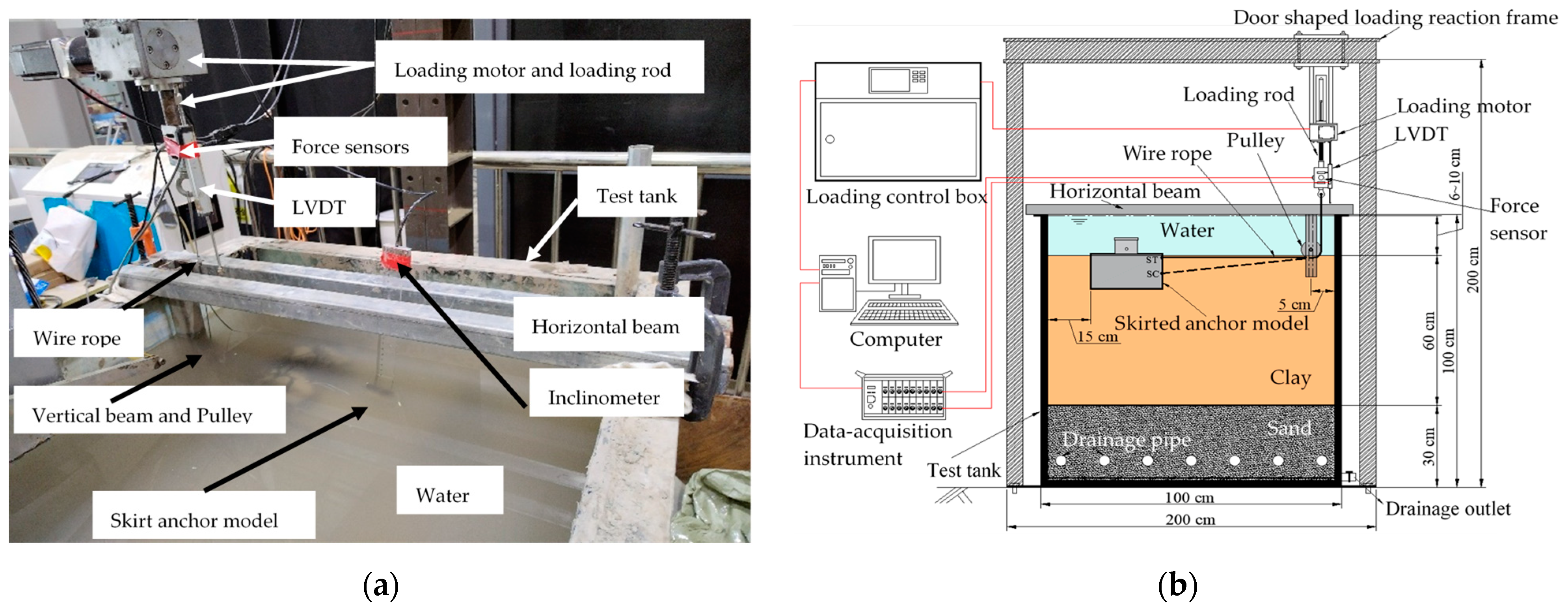
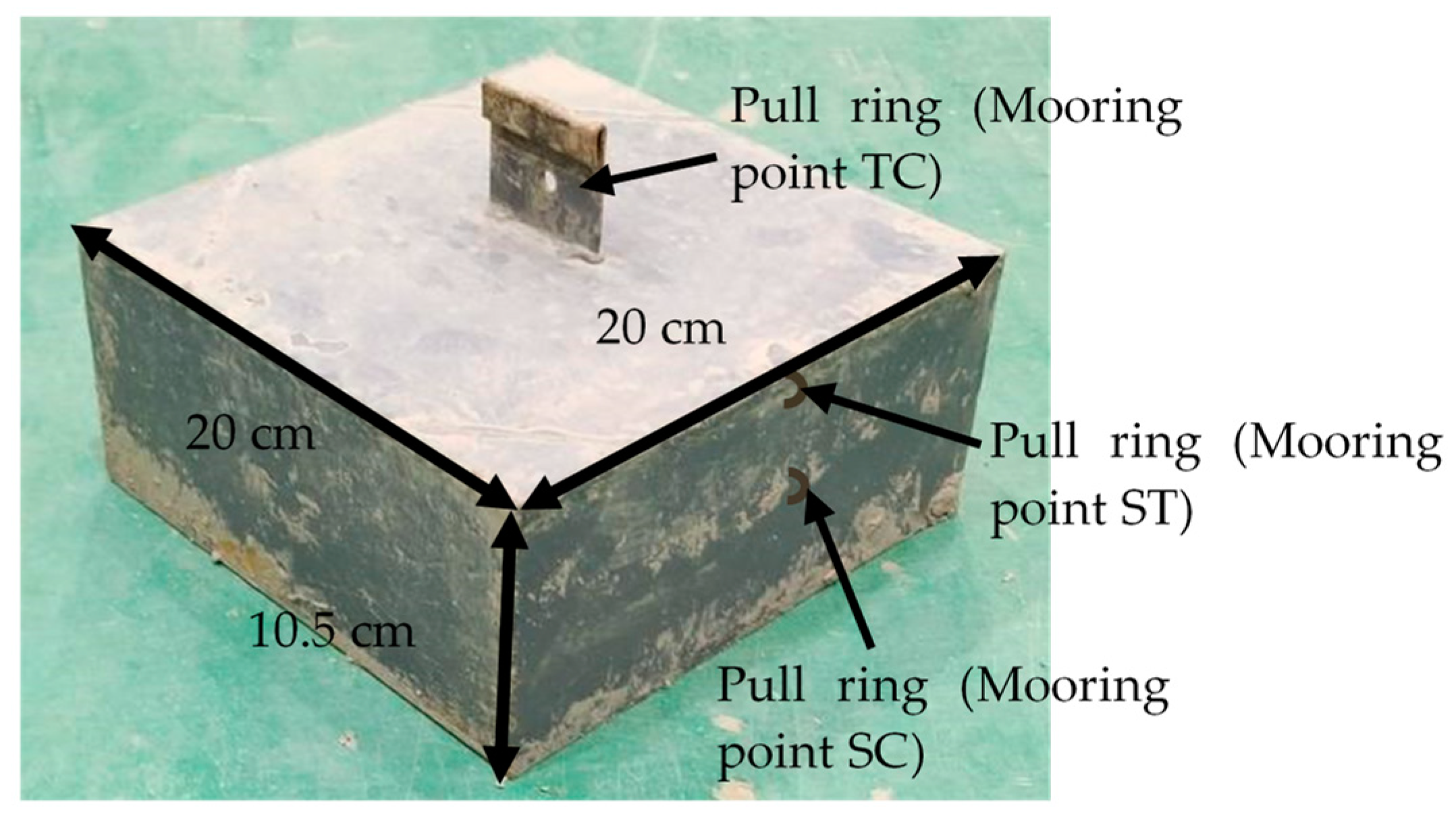

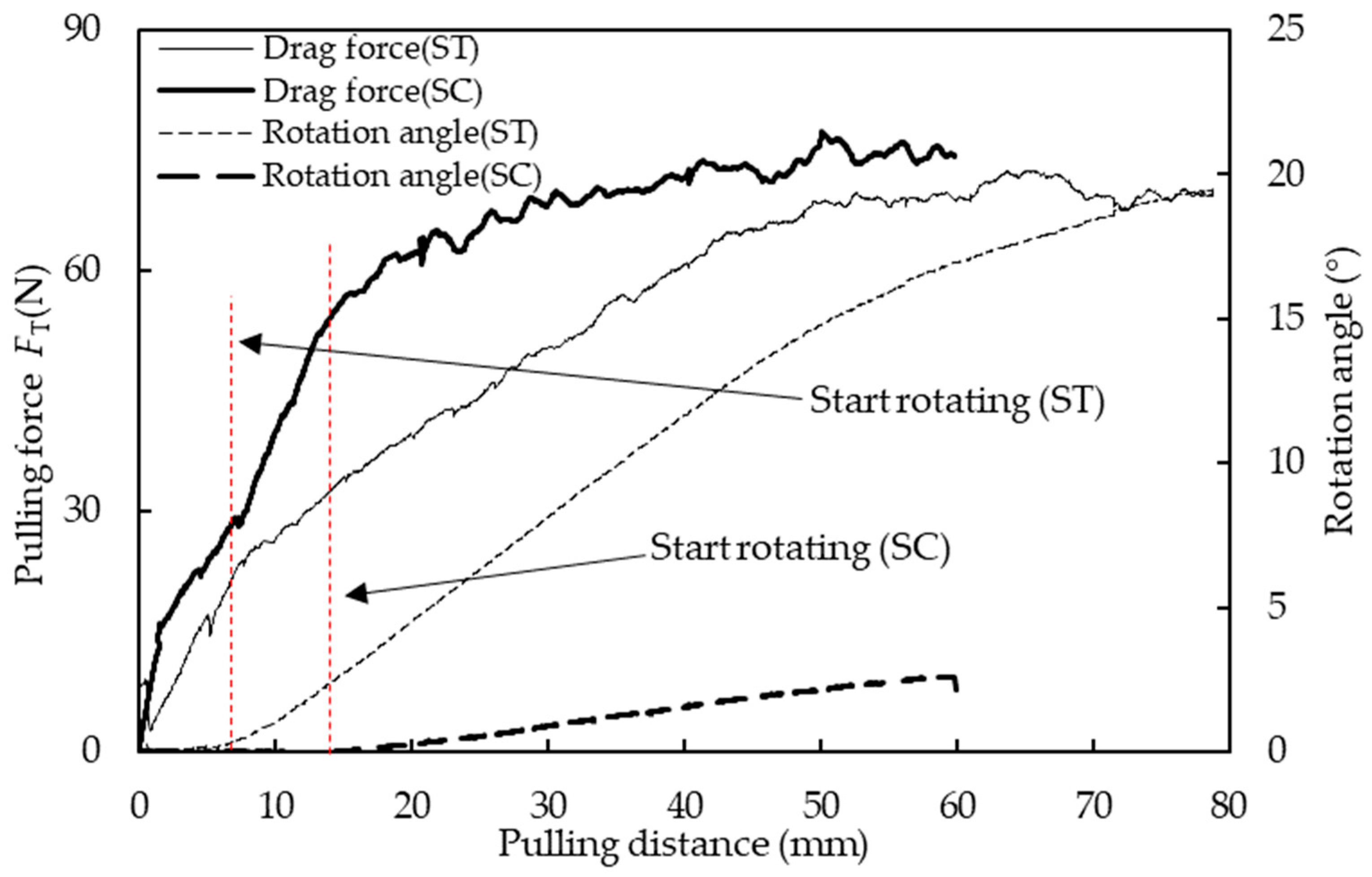
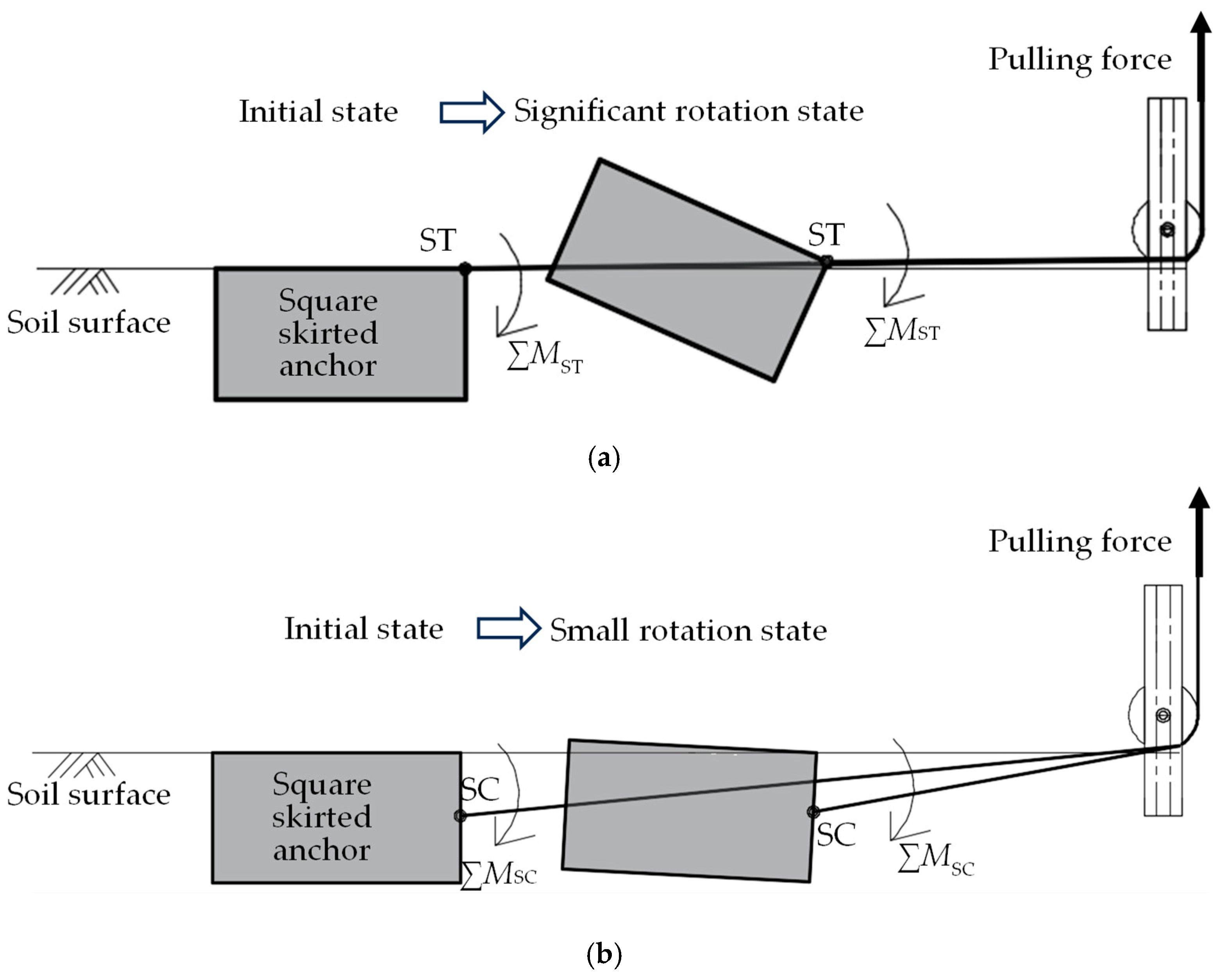
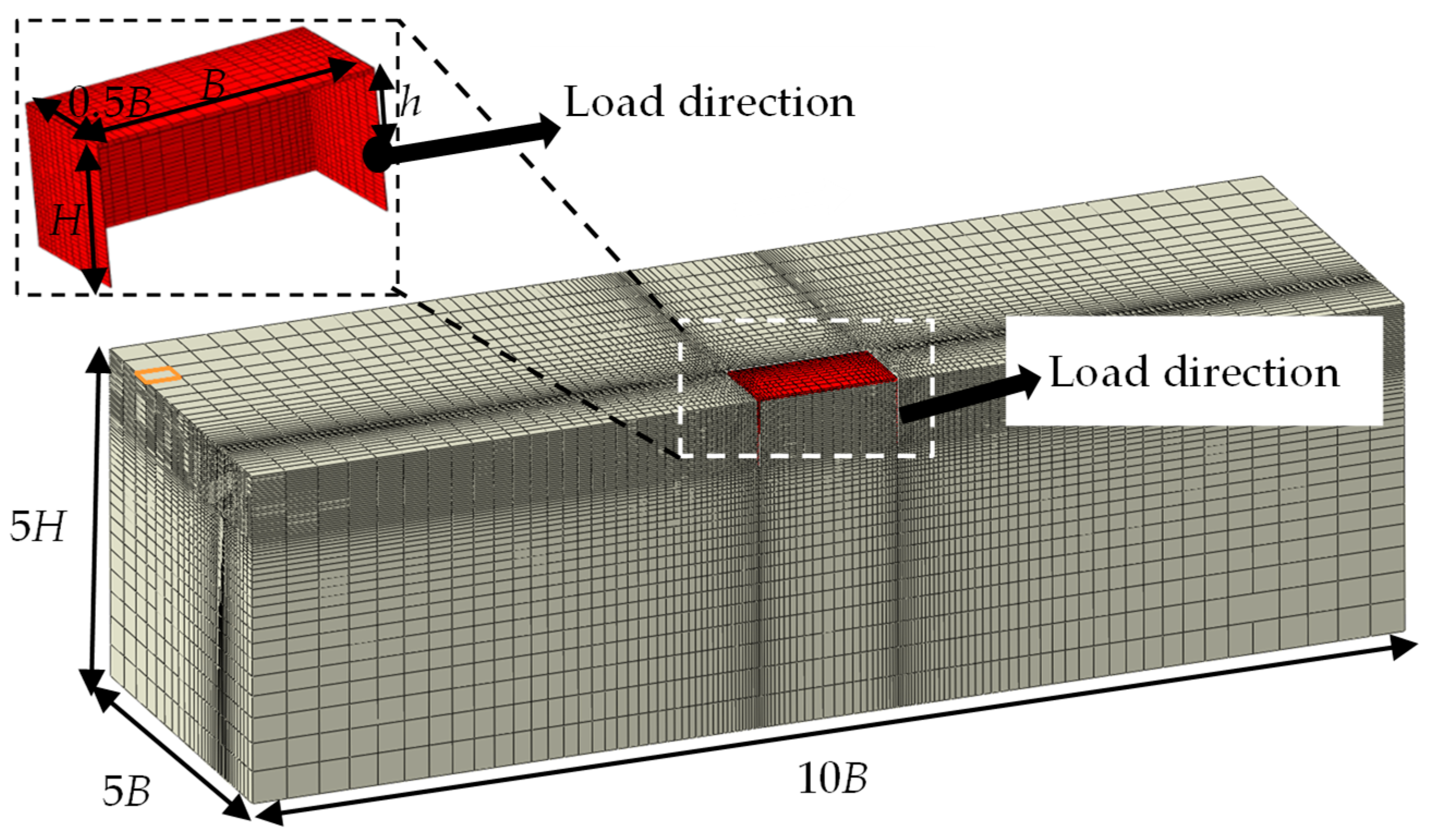
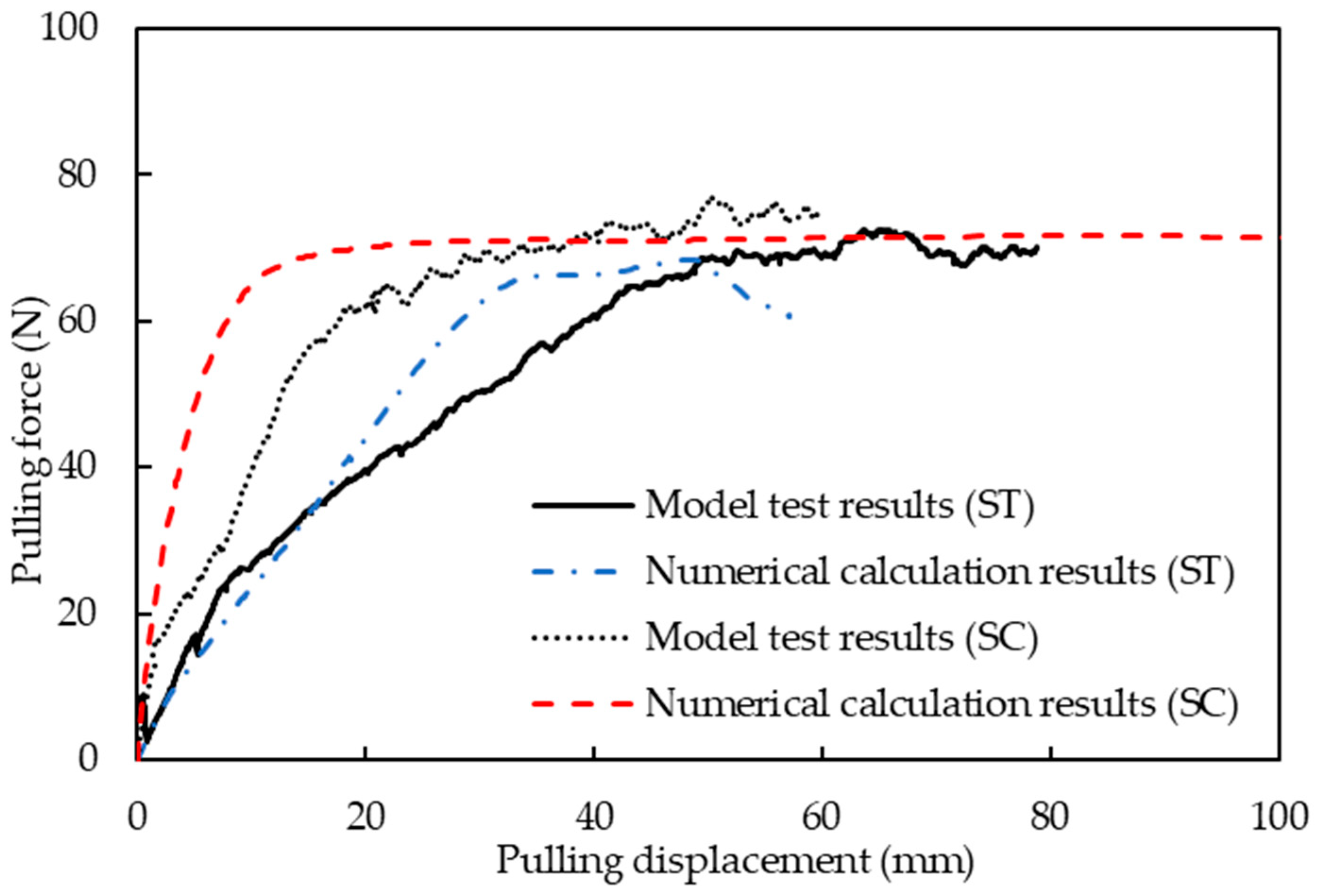

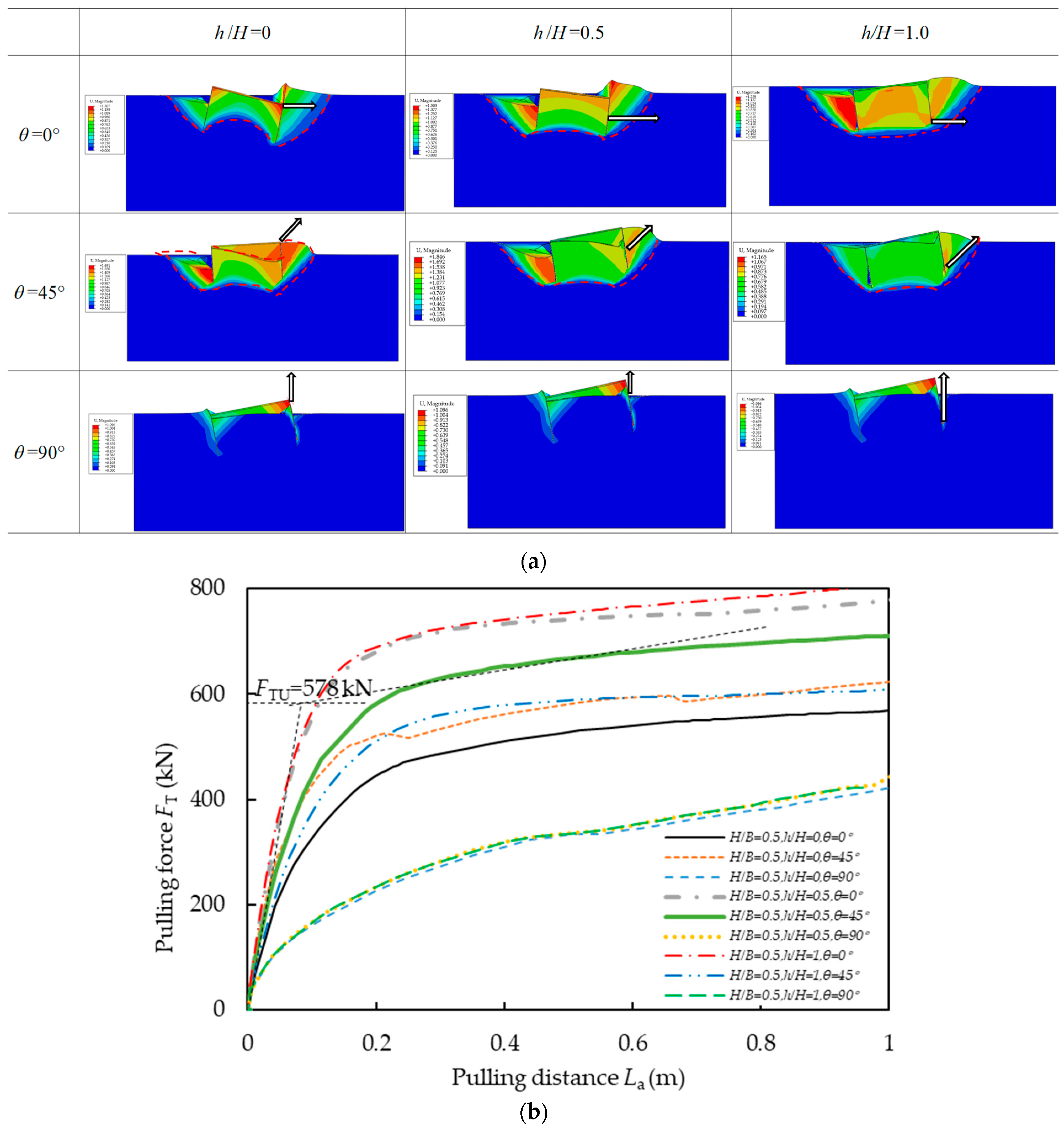
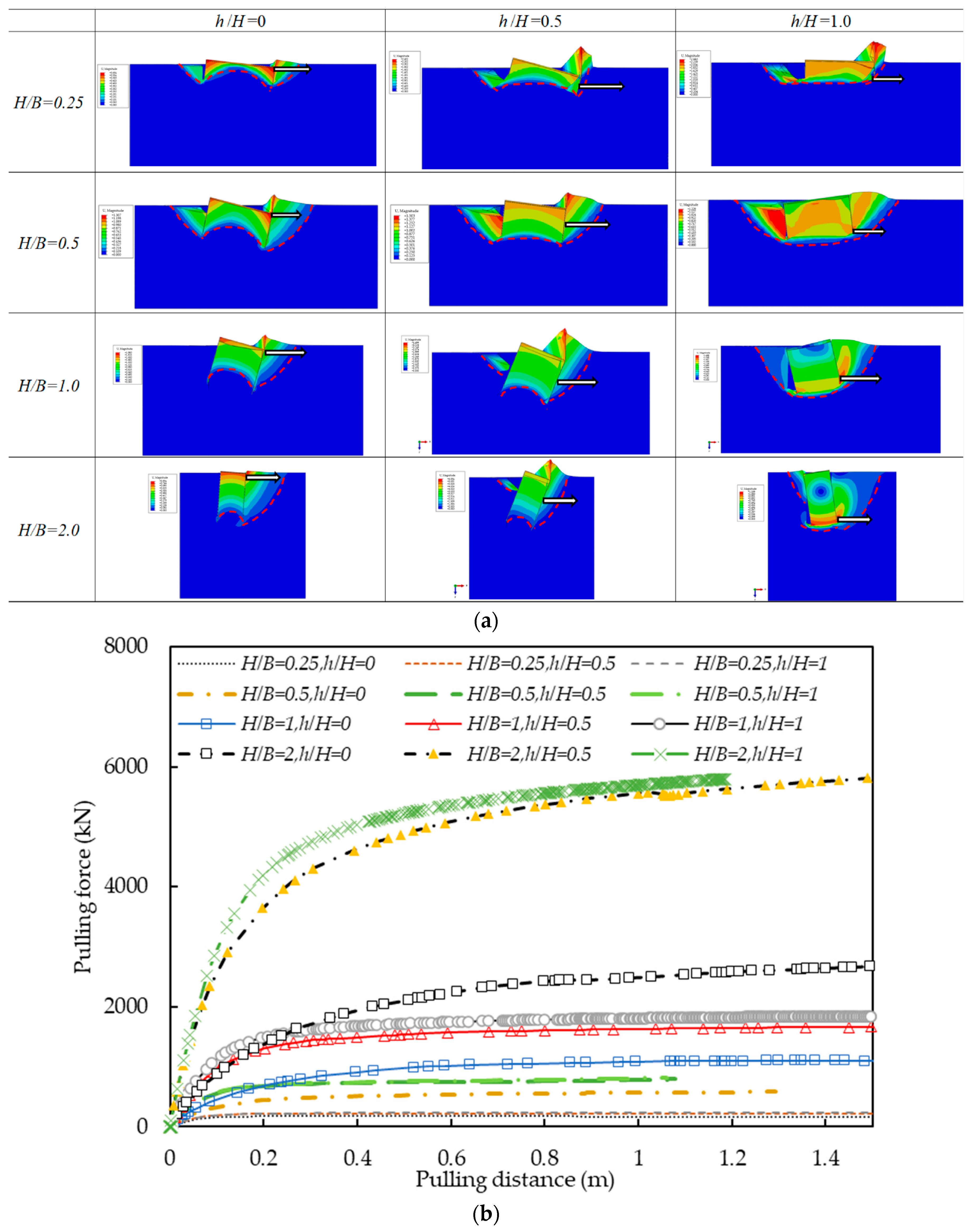
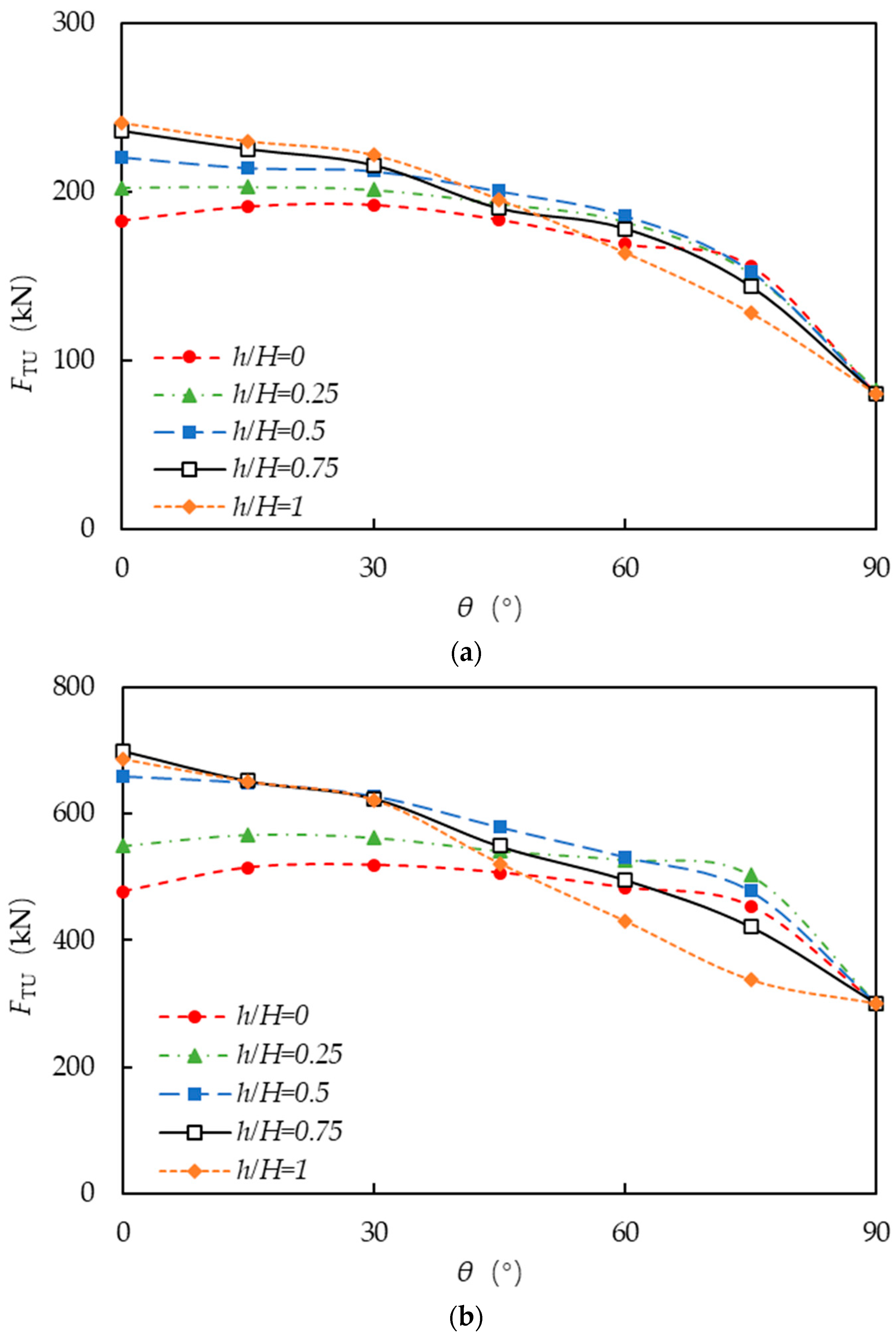
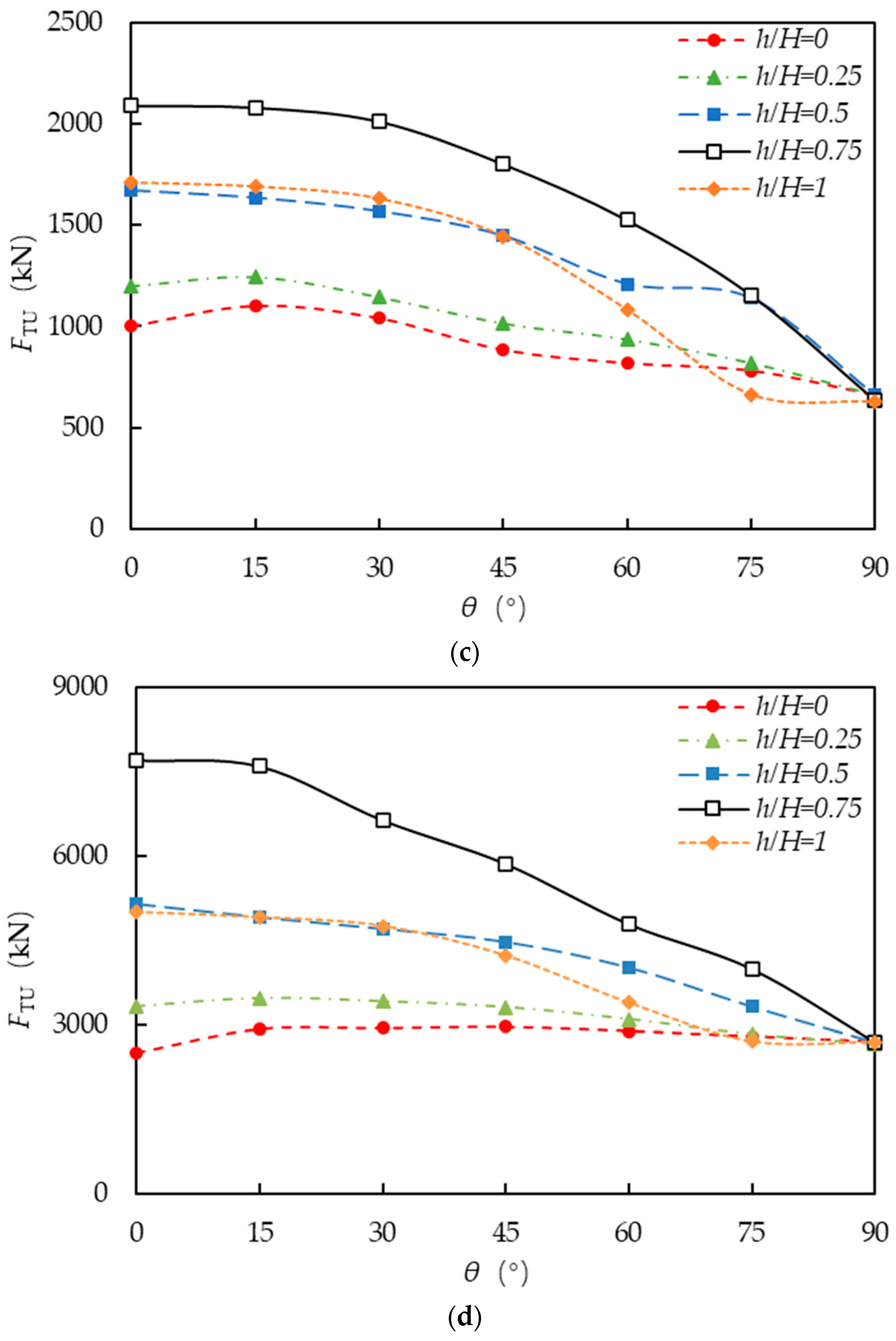

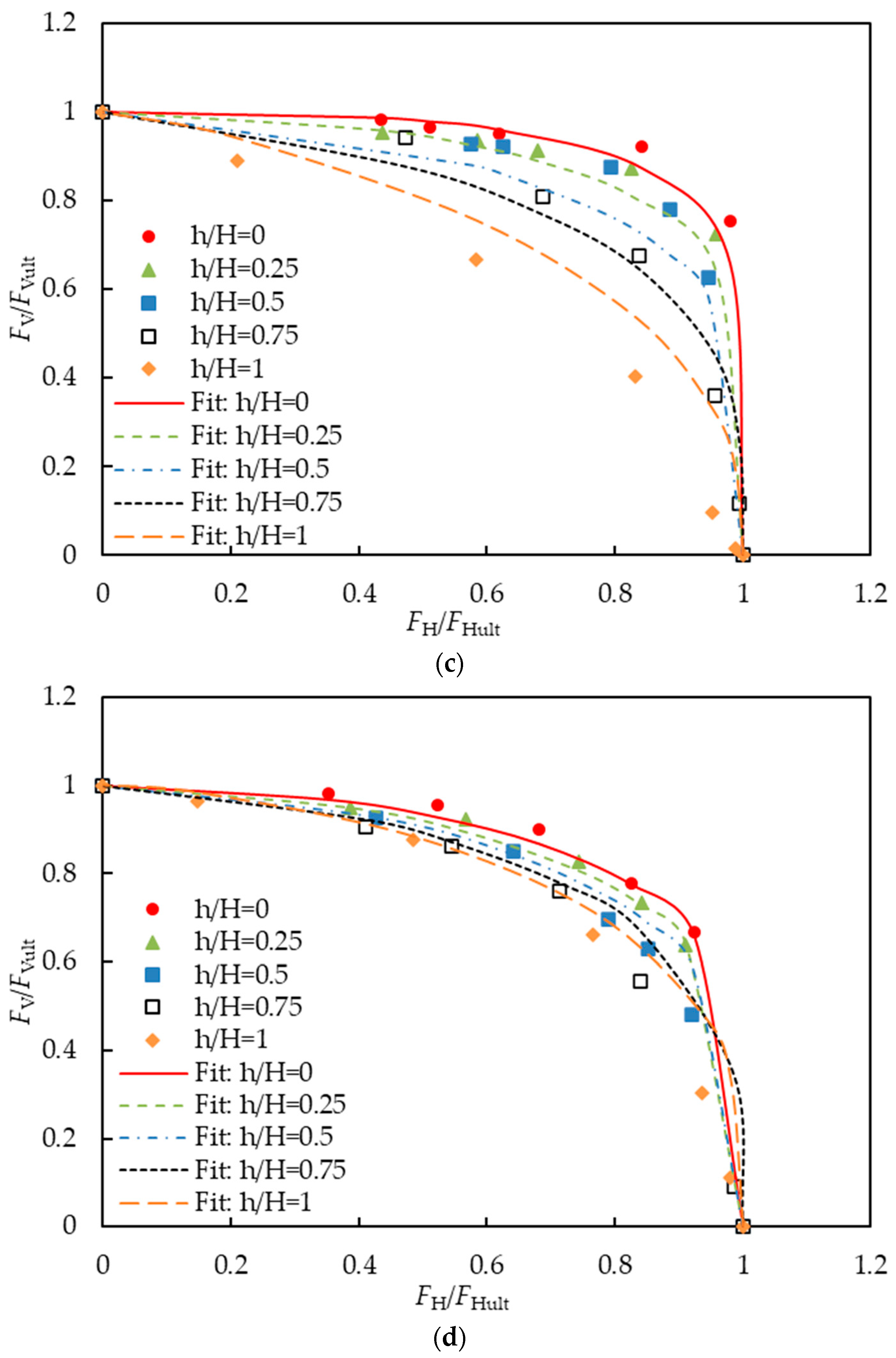
| Parameter | Value |
|---|---|
| Slope of the critical state line CSL in p′-q space, M (-) | 1.2 |
| Slope of the normal consolidation line NCL in the e-lnp′ space, λ (-) | 0.22 |
| Slope of the unloading rebound line SL in the e-lnp′ space, κ (-) | 0.055 |
| Intercept of the critical state line CSL in e-lnp′ space, ecs (-) | 1.9 |
| Effective weight of soil, γ′ (kN/m3) | 6 |
| Poisson’s ratio of soil, μ (-) | 0.33 |
| Soil permeability coefficient, k (m/s) | 1 × 10−9 |
| Variables | Values |
|---|---|
| Aspect ratio H/B | 0.25, 0.5, 1.0, 2.0 |
| Load inclination angle θ | 0°, 15°, 30°, 45°, 60°, 75°, 90° |
| Mooring point h/H | 0, 0.25, 0.5, 0.75, 1.0 |
Disclaimer/Publisher’s Note: The statements, opinions and data contained in all publications are solely those of the individual author(s) and contributor(s) and not of MDPI and/or the editor(s). MDPI and/or the editor(s) disclaim responsibility for any injury to people or property resulting from any ideas, methods, instructions or products referred to in the content. |
© 2024 by the authors. Licensee MDPI, Basel, Switzerland. This article is an open access article distributed under the terms and conditions of the Creative Commons Attribution (CC BY) license (https://creativecommons.org/licenses/by/4.0/).
Share and Cite
Wang, Y.; Li, S.; Sun, L.; Ren, Y. A Study on the Bearing Capacity of Square Skirted Anchors with Different Mooring Points. J. Mar. Sci. Eng. 2024, 12, 1572. https://doi.org/10.3390/jmse12091572
Wang Y, Li S, Sun L, Ren Y. A Study on the Bearing Capacity of Square Skirted Anchors with Different Mooring Points. Journal of Marine Science and Engineering. 2024; 12(9):1572. https://doi.org/10.3390/jmse12091572
Chicago/Turabian StyleWang, Yandi, Sa Li, Liqiang Sun, and Yuxiao Ren. 2024. "A Study on the Bearing Capacity of Square Skirted Anchors with Different Mooring Points" Journal of Marine Science and Engineering 12, no. 9: 1572. https://doi.org/10.3390/jmse12091572






